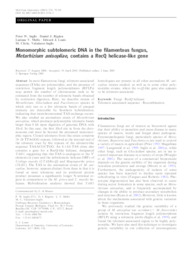Monomorphic subtelomeric DNA in the filamentous fungus, Metarhizium anisopliae, contains a RecQ helicase-like gene.
Monomorphic subtelomeric DNA in the filamentous fungus, Metarhizium anisopliae, contains a RecQ helicase-like gene.
Resumo: In most filamentous fungi, telomere-associated sequences (TASs) are polymorphic, and the presence of restriction fragment length polymorphisms (RFLPs) may permit the number of chromosome ends to be estimated from the number of telomeric bands obtained by restriction digestion. Here, we describe strains of Metarhizium, Gliocladium and Paecilomyces species in which only one or a few telomeric bands of unequal intensity are detectable by Southern hybridization, indicating that interchromosomal TAS exchange occurs. We also studied an anomalous strain of Metarhizium anisopliae, which produces polymorphic telomeric bands larger than 8 kb upon digestion of genomic DNA with XhoI. In this case, the first XhoI site in from the chromosome end must lie beyond the presumed monomorphic region. Cloned telomeres from this strain comprise 18?26 TTAGGG repeats, followed at the internal end of the telomere tract by five repeats of the telomere-like sequence TAAACGCTGG. An 8.1-kb TAS clone also contains a gene for a RecQ-like helicase, designated TAH1, suggesting that this TAS is analogous to the Y elements in yeast and the subtelomeric helicase ORFs of Ustilago maydis (UTASRecQ) and Magnaporthe grisea (TLH1). The TAS in the anomalous strain of M. anisopliae, however, appears distinct from these in that it is found at most telomeres and its predicted protein product possesses a significantly longer N-terminal region in comparison to the M. grisea and U. maydis helicases. Hybridization analyses showed that TAH1 homologues are present in all other anomalous M. anisopliae strains studied, as well as in some other polymorphic strains, where the recQ-like gene also appears to be telomere-associated.
Ano de publicação: 2005
Tipo de publicação: Artigo de periódico
Palavras-chave: Fungo, Metarhizium Anisopliae, RecQ helicase, Recombination, Telomere associated sequence
Observações
1 - Por padrão são exibidas publicações dos últimos 20 anos. Para encontrar publicações mais antigas, configure o filtro ano de publicação, colocando o ano a partir do qual você deseja encontrar publicações. O filtro está na coluna da esquerda na busca acima.
2 - Para ler algumas publicações da Embrapa (apenas as que estão em formato ePub), é necessário ter, no celular ou computador, um desses softwares gratuitos. Sistemas Android: Google Play Livros; IOS: iBooks; Windows e Linux: software Calibre.
Acesse outras publicações
Acesse a Base de Dados da Pesquisa Agropecuária (BDPA) para consultar o acervo completo das bibliotecas da Embrapa.

